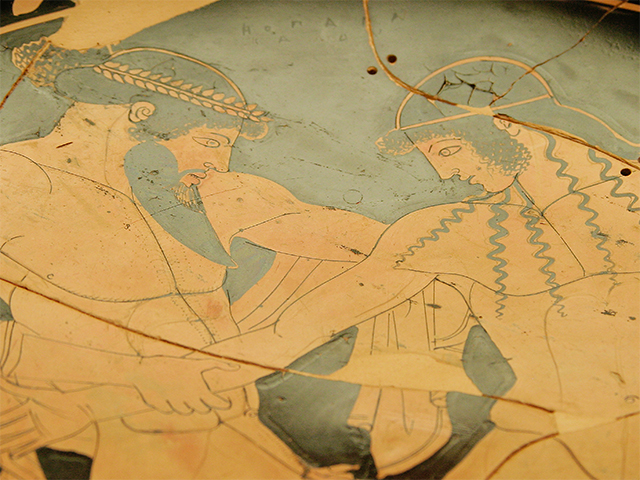National Etruscan Museum of Tarquinia
Etruscan Museum of Tarquinia: opening hours, tickets and information about Italy's most important Etruscan art museum.The National Etruscan Museum of Tarquinia, held within Palazzo Vitelleschi, is beyond doubt one of the richest and most importnat museums of Italy. Authentic architectonical masterpiece from the Renaissance, it was built by will of Cardinal Giovanni Vitelleschi between 1436 and 1439 based on a project by Giovanni Dalmata.
The buildings vaunts the co-presence of Gothic and Renaissance elements, proofs from the gradual passage to the new style, spreading precisely during those years. The Renaissance signs are evident in the left sector, where the portal is surmounted by a triangular tympanum, including the coat of arms of the Vitelleschi family. In the central sector there are copies of mullioned windows and in the right sector, three three mullioned windows, reminding of Gothic style.
Once you overpass the main entrance, you will be in a wide courtyard provided with an octagonal well dating back to 1459, surrounded on both sides by a portico with pointed archways.
The definitive transformation of the building into a museum took place in 1924 when, to the original core of the town collection, including many finds from excavations done over the nineteenth century in the area of Tarquinia, were added the collections Bruschi-Falgàri and other contributions from town noble families.
Since then, the collection has been progressively incresing, also with the addition, in the early fifties of last century, of four tombs coming from the neighboring Necropolis of Monterozzi.

National Etruscan Museum of Tarquinia
The courtyard at the entrance of the Museum with the octogonal well and the portico with pointed archways
VISIT ITINERARY
The exhibition of the Museum is divided over three floors.
GROUND FLOOR
The spaces at the ground floor host, in chronological sequence, stone materials belonging to the museum collections, like sarcophagus dating back to halfway through the fourth century BC. Worth noting, room 10 cointaining the most value sarcophagu, some sculpted in Greek marble, that had belonged to some famous families of Tarquinia by mid fourth century BC.
Among the most important, the sarcophagus of Laris and Velthur, both belonging to the Partunus family, the Obese, the Magistrate, the Magnate and the Priest.
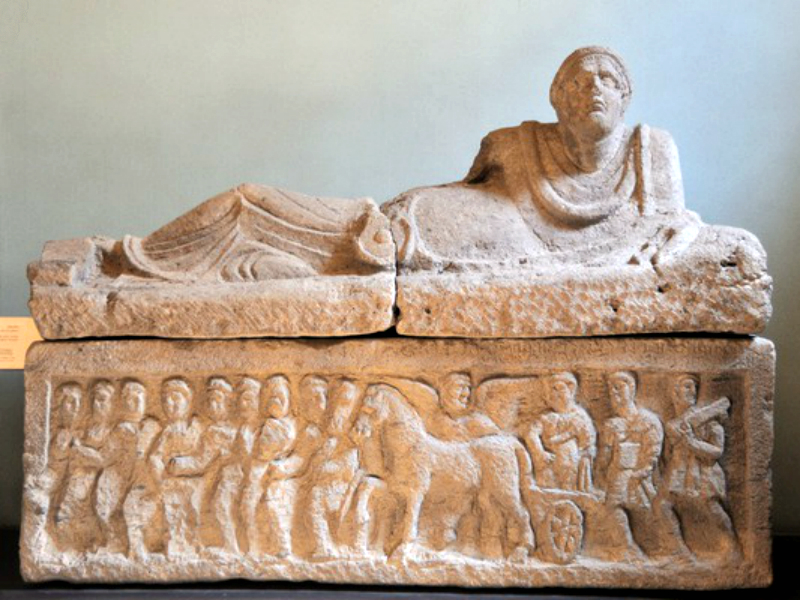
Etruscan Museum of Tarquinia - Sarcophagus of Laris

Etruscan Museum of Tarquinia - Sarcophagus of Veltur
FIRST FLOOR
On the first floor, a rich collection of finds, from Villanovian to Roman period, are exhibited in chronological order. They furnish proof of Greek and Etruscan paint evolution.
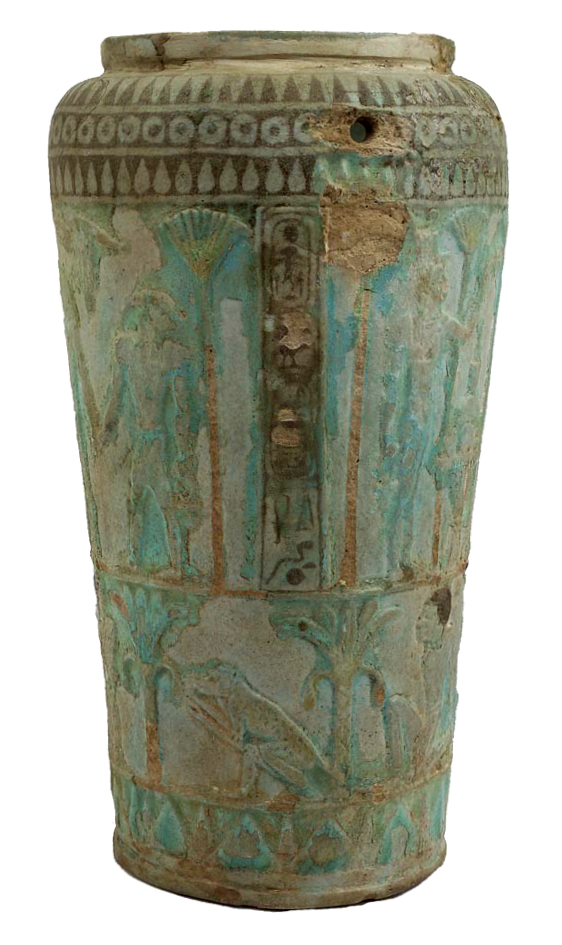
The Vase of Bocchoris
Of remarkable beauty, as grave goods it's worth noting the vase of Bocchoris (seventh-sixth century BC), as well as many Greek vases with black figures from the sixth century BC and Attic vases with red figures.
We recommend to you to start your visit from the last room of the gallery, where the oldest finds are gathered, dating back to the Villanovian period (ninth-eight century BC). The following rooms, arranged in chronological order, contain finds coming from Phoenicia and Egypt (late eight - seventh century BC), important vases from Greece (specially Corinth) dating back to the end of the seventh and the sixth centuries BC, and buccheri, typica Etruscan ceramics.
You will find next, imported ceramics coming from Attic (Greece), cuilt with the technique of black and red figures, dating back to the sixth century BC.
In a window of the "Salone delle Feste" (Ballroom) there is a selection of bronze and gold Etruscan coins, dating back to late Imperial age, discovered during the excavations in the Roman colony of Gravisca, and some gold jewelry made using granulation process.
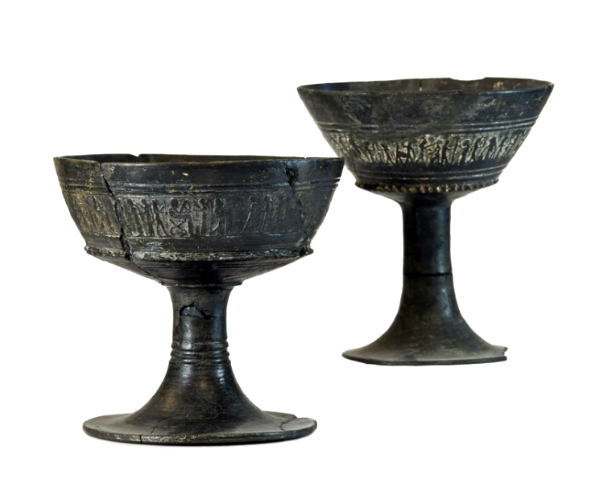
Examples of Buccheri, the characteristic Etruscan ceramics
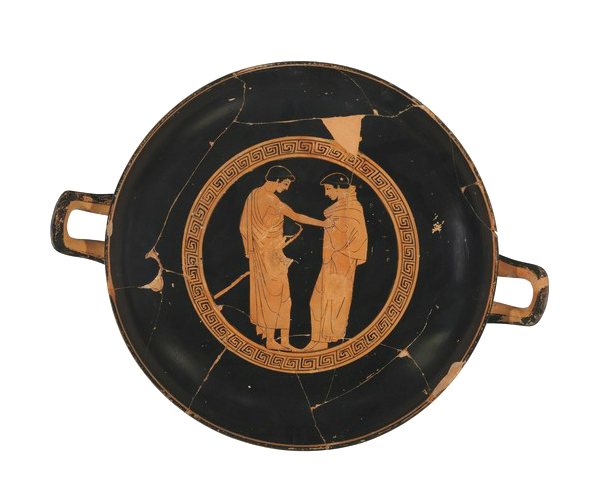
Attic Ceramics with red and black figures
Continuing to the following rooms, you can admirare finds of local production, both ceramics and metal: mirrors, small ceramic bottles, furnishings. In the last room there is a gathering of the so-called ex voto, meaning gifts offered to divinities to receive help, coming from the sanctuary of the Altar of the Queen. Most of them reproduce, in terracotta, parts of the human body, or heads of people fro whom the protection of the divinity was asked.
SECOND FLOOR
On the second floor there is a quadrangular loggia from where you can enjoy a wonderful view over the city and the countryside. In a group of air-conditioned rooms, have been preserved and reconstiruted some painted tombs, which frescos have been removed: we are talking about theTriclinium, Chariots, Olympics and Ship tombs.
The famous high-relief of the Winged Horses, salvaged from the ruins of the temple of the Altar of the Queen, has been temporarily exhibited since 2001 to date in Salone delle Armi (Room of the Arms). It finally returned go back to the room which was originally meant for to suitably display this unique artwork in all its relevance and importance.
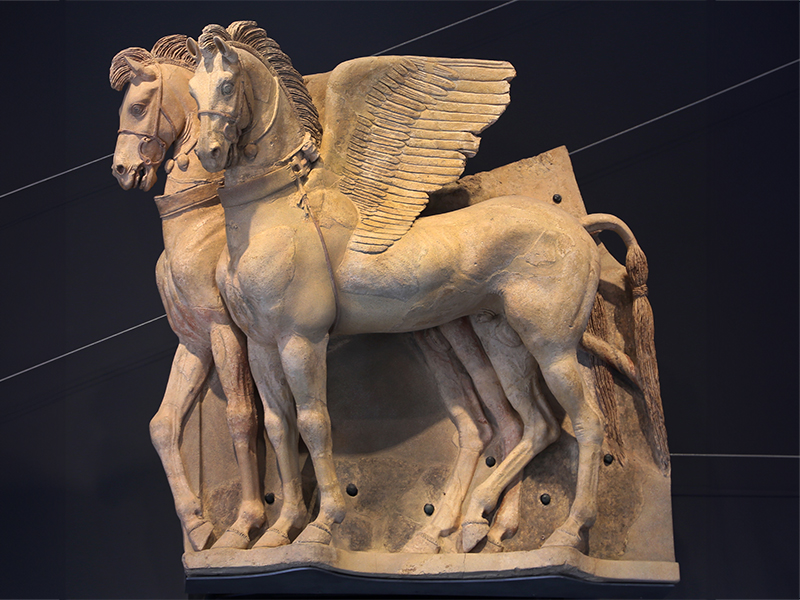
The Winged Horses - Photo by Sailko, Own work, CC BY 3.0
To complete the exhibiton, a collection of finds discovered during the large excavations in Tarquinia, managed by Università di Milano regarding the Etruscan city, and by Università di Perugia regarding the emporion of Gravisca.
Read the box below to find all useful information to organize your visit to the museum to the best.
Useful information
National Etruscan Museum of Tarquinia
- HOW TO GET THERE
- Public transports- From Piazza Vittorio Emanuele (Cathedral) you can get a COTRAL bus line bound for Tarquinia (Barriera S.Giusto) that will drop you within walking distance to the Museum.- Close to Largo della Pace and Fort Michelangelo you can also take the Eusepi Bus (except on Sundays), stopping at Barriera S.Giusto, close to the Etruscan Museum. Tickets costs €2 each way. For information about times please refer to the official site.By car- From Rome: take the highway until Civitavecchia and then the main road Aurelia (90 km).- From Grosseto: Main road Aurelia towards south (90 km).- From Viterbo: via Vetralla - Monte Romano or via Tuscania; in both cases, no more than 45 km.
- TIMETABLES
- Tuesday - Sunday: 9:00/19:30 (the ticket office closes at 6.30pm).
Weekly closing day: MondayHolidays closing days: 1 January and 25 December - PRICES
- Full price ticket: €10Reductions: €2 (between 18 and 25 years old)



 PORT MOBILITY CIVITAVECCHIA
PORT MOBILITY CIVITAVECCHIA








